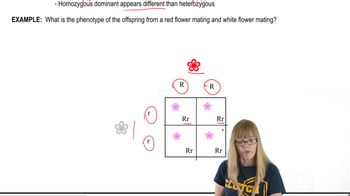Table of contents
- 1. Introduction to Genetics51m
- 2. Mendel's Laws of Inheritance3h 37m
- 3. Extensions to Mendelian Inheritance2h 41m
- 4. Genetic Mapping and Linkage2h 28m
- 5. Genetics of Bacteria and Viruses1h 21m
- 6. Chromosomal Variation1h 48m
- 7. DNA and Chromosome Structure56m
- 8. DNA Replication1h 10m
- 9. Mitosis and Meiosis1h 34m
- 10. Transcription1h 0m
- 11. Translation58m
- 12. Gene Regulation in Prokaryotes1h 19m
- 13. Gene Regulation in Eukaryotes44m
- 14. Genetic Control of Development44m
- 15. Genomes and Genomics1h 50m
- 16. Transposable Elements47m
- 17. Mutation, Repair, and Recombination1h 6m
- 18. Molecular Genetic Tools19m
- 19. Cancer Genetics29m
- 20. Quantitative Genetics1h 26m
- 21. Population Genetics50m
- 22. Evolutionary Genetics29m
3. Extensions to Mendelian Inheritance
Variations of Dominance
Problem 6a
Textbook Question
The ABO and MN blood groups are shown for four sets of parents (1 to 4) and four children (a to d). Recall that the ABO blood group has three alleles: I^A, I^B and i. The MN blood group has two codominant alleles, M and N. Using your knowledge of these genetic systems, match each child with every set of parents who might have conceived the child, and exclude any parental set that could not have conceived the child. <>
 Verified step by step guidance
Verified step by step guidance1
<span>Step 1: Understand the genetic systems involved. The ABO blood group system has three alleles: I^A, I^B, and i. The MN blood group system has two codominant alleles: M and N. Each parent contributes one allele from each system to their child.</span>
<span>Step 2: List the possible genotypes for each blood group. For ABO, the possible genotypes are I^A I^A, I^A i, I^B I^B, I^B i, I^A I^B, and ii. For MN, the possible genotypes are MM, MN, and NN.</span>
<span>Step 3: For each set of parents, determine the possible alleles they can pass on to their child. This involves considering all combinations of the parents' alleles for both the ABO and MN systems.</span>
<span>Step 4: For each child, determine their genotype for both the ABO and MN blood groups. This will help in matching them with potential parent sets.</span>
<span>Step 5: Compare the child's genotype with the possible genotypes from each set of parents. Exclude any parent set that cannot produce the child's genotype based on the alleles they can pass on.</span>
Recommended similar problem, with video answer:
 Verified Solution
Verified SolutionThis video solution was recommended by our tutors as helpful for the problem above
Video duration:
2mPlay a video:
Was this helpful?
Key Concepts
Here are the essential concepts you must grasp in order to answer the question correctly.
ABO Blood Group System
The ABO blood group system is determined by three alleles: I^A, I^B, and i. The I^A and I^B alleles are codominant, meaning that if both are present, the resulting phenotype will express both A and B antigens on the red blood cells. The i allele is recessive, leading to the O blood type when present in homozygous form (ii). Understanding these alleles is crucial for predicting possible blood types of offspring based on parental genotypes.
Recommended video:
Guided course

Variations on Dominance
MN Blood Group System
The MN blood group system consists of two codominant alleles, M and N. Individuals can have one of three genotypes: MM, MN, or NN, which correspond to the presence of M or N antigens on the surface of red blood cells. Since both alleles are expressed equally when present, this system allows for a straightforward determination of potential offspring blood types based on parental combinations.
Recommended video:
Guided course

Variations on Dominance
Punnett Square and Genetic Prediction
A Punnett square is a tool used in genetics to predict the genotypes of offspring from parental genotypes. By laying out the possible allele combinations from each parent, one can visualize and calculate the likelihood of each genotype and phenotype in the offspring. This method is essential for solving questions related to inheritance patterns, such as matching children to their possible parents based on blood group phenotypes.
Recommended video:
Guided course

Chi Square Analysis

 4:37m
4:37mWatch next
Master Variations on Dominance with a bite sized video explanation from Kylia Goodner
Start learningRelated Videos
Related Practice

